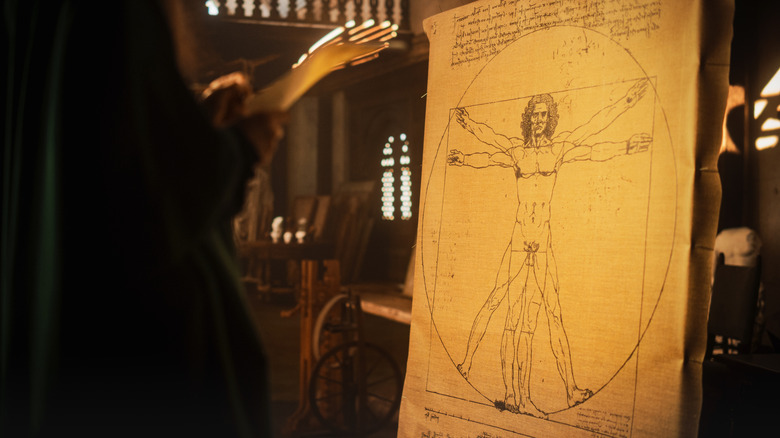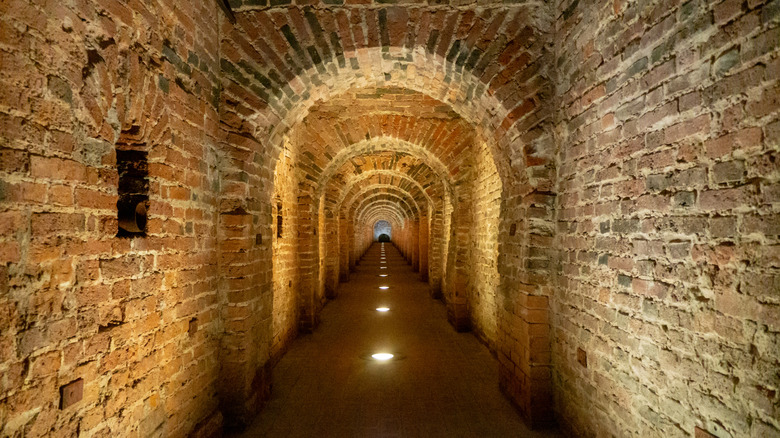Leonardo Da Vinci's Sketches Led Archeologists To A Centuries-Old Secret
So what do we get if we combine, 1) An enigmatic Leonardo da Vinci drawing, 2) A stunning Milanese castle with secret passageways, and 3) Ground-penetrating radar? If you said, "The next Dan Brown novel," you might be right — time will tell. But if you also said, "The subject of an ultra-cool Ph.D. thesis at the Polytechnic University of Milan," then you'd also be correct.
That's the story in a nutshell, and it all started with polymath and irrefutable 15th-century Italian Renaissance genius, Leonardo da Vinci. Da Vinci made equally insightful explorations into realms of engineering, architecture, and human anatomy. The latter of these forays granted us artwork like the famed "Vitruvian Man" illustration and two of the most revered paintings of all time: "The Last Supper" and the "Mona Lisa." But in all cases, art-related or not, much of what we know about da Vinci comes to us from his detailed, fine-pencil sketches.
Enter a da Vinci sketch that's left people scratching their heads for years: Drawings of secret castle corridors under Sforza Castle in Milan. Francesco Sforza, the Duke of Milan, started work on this castle in 1460. His son and successor, Ludovico, hired da Vinci to decorate the structure in 1494. Da Vinci did exactly this, and he came to know the castle very well. This is why many speculated that the corridors in da Vinci's drawings were real. And now, thanks to the Polytechnic University of Milan, we know that they are — corridors that gave the duke an easy way to visit his wife's tomb.
The tale of a duke and his wife
Isn't it perfectly fitting that a mysterious Leonardo da Vinci drawing would be a portal to another, greater story? Bear in mind that da Vinci didn't create the secret passageways under Sforza Castle. He decorated the castle along with other artists like Bernardino Zenale and Bernardino Butinone, and their work includes the famed frescos for the Sala delle Asse, aka the Falconer's Tower. Da Vinci catalogued his sketches for this art and others in notebooks, five of which have been bound together into what's called "Codex Forster I." It's in this compilation that we find sketches of passageways underneath Sforza Castle.
Since Sforza Castle was a fortified structure — not just the Sforza residence — such passageways would have been built for militaristic purposes. After all, the entire site was erected on top of a ruined medieval fortress. Over time, Francesco Sforza's structure grew to have towers at the corners, courtyards, a library, a lake, and more. But the passageways underneath remained out of sight of the public until recently, thanks to the Polytechnic University of Milan.
One key passageway runs from Sforza Castle to the nearby Basilica of Santa Maria delle Grazie, about a 12-minute walk on Milan's current streets. That church houses da Vinci's "The Last Supper" as well as the tombs for the Sforza family. This includes Beatrice d'Este, wife of Duke Ludovico Sforza, who died in 1497 after giving birth to a stillborn son. The general consensus is that Ludovico constructed the passageway from the castle to the basilica to more easily visit Beatrice's tomb.
3D models based on ground-penetrating radar
It took until 2025 for anyone to put the truth of Leonardo da Vinci's sketches to the test. As a part of a Ph.D. thesis, some intrepid students/researchers from Politecnico di Milano (Polytechnic University of Milan) used ground-penetrating radar to discover — ding, ding — that da Vinci's drawings speak true. With support from Codevintec, a ground and marine imaging company, the research team used georadar and laser scanners to not only confirm that passages under Szorfa Castleexist but also to map them out in detail. "The ground-penetrating radar enriched the 3D model with data on known but inaccessible spaces, bringing to light unknown walkways and ideas for further studies on secret passages," said Polytechnic University of Milan researcher Francesca Biolo.
The 3D rendering is apparently so good that there are plans in place to leverage the current study for tourist purposes. After all, Sforza Castle is already a massive tourist hotspot that contains multiple museums. As Polytechnic University of Milan professor Franco Guzzetti explained, the idea is to use the 3D-generated passageway data "to create a digital twin of the Sforza Castle, a digital model that not only represents the current appearance of the castle but also allows you to explore the past, recovering historical elements that are no longer visible." Using this digital model, there's even talk of creating an augmented reality (AR) version of the castle that people can explore, allowing them to access places otherwise out of reach. So basically: Thanks, da Vinci.


